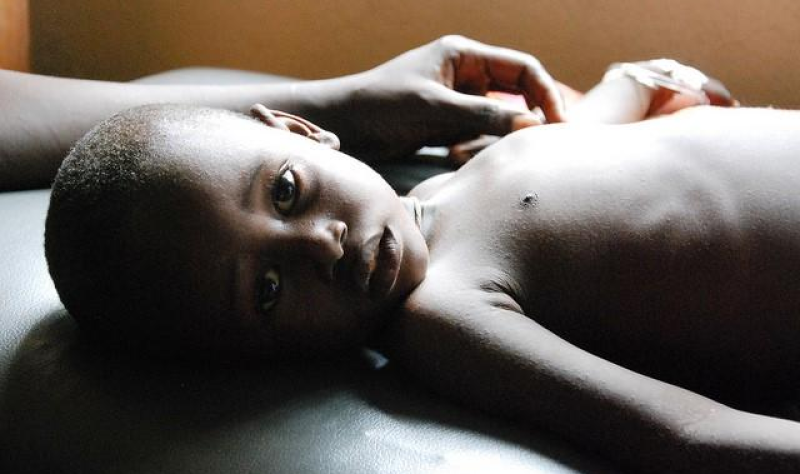DFID / Flickr cc
Continued US defunding of the US Agency for International Development (USAID) foreign-aid program could result in more than 14 million excess deaths—including 4.5 million preschool children—from preventable infectious diseases in the next 5 years, threatening over 20 years of progress, an international group of researchers warned yesterday in The Lancet.
“For many LMICs [low- and middle-income countries], the resulting shock would be similar in scale to a global pandemic or a major armed conflict,” the researchers wrote. “Unlike those events, however, this crisis would stem from a conscious and avoidable policy choice—one whose burden would fall disproportionately on children and younger populations, and whose consequences could reverberate for decades.”
Scientists in Brazil, Spain, Mozambique, and the United States analyzed data from 133 countries and territories—including all LMICs—receiving no to very high USAID support.
The team modeled demographic, socioeconomic, and healthcare data to estimate the impact of USAID funding on all-age and all-cause deaths from 2001 to 2021, as well as effects by age-, sex, and cause-specific groups. Last, they used microsimulation models to estimate the effects up to 2030.
Our estimates show that, unless the abrupt funding cuts announced and implemented in the first half of 2025 are reversed, a staggering number of avoidable deaths could occur by 2030.
Higher USAID funding levels—mainly for LMICs in Africa—were tied to a 15% reduction in age-standardized, all-cause deaths (risk ratio [RR], 0.85) and a 32% cut in deaths among children younger than 5 years (RR, 0.68). This indicates that USAID financing prevented 91.8 million all-age deaths, including 30.4 million preschool children, from 2001 to 2021, the authors said.
The financial support was linked to a 65% reduction in deaths from HIV/AIDS (representing 25.5 million deaths) and reductions of 51% and 50% from malaria (8.0 million) and neglected tropical diseases (8.9 million), respectively.
Significant declines were also seen in deaths from tuberculosis, malnutrition, diarrheal illnesses, lower respiratory-tract infections, and maternal and perinatal conditions. Models predicted that continued USAID funding cuts could lead to more than 14.1 million excess all-age deaths, including 4.5 million in children younger than age 5, by 2030.
“Our estimates show that, unless the abrupt funding cuts announced and implemented in the first half of 2025 are reversed, a staggering number of avoidable deaths could occur by 2030,” the researchers wrote. “These results provide essential evidence for policy makers, planners, and advocates navigating the future of US global health engagement.”
USAID, the world’s largest funding agency for humanitarian and development, is estimated to have helped avert more than 91 million deaths—including 30 million in the pediatric population—over the past 20 years. It has been funded by high-income nations around the world.
In January 2025, the Trump administration suspended foreign-aid programs other than emergency food assistance and military aid. In March, the United States announced the cancellation of 83% of USAID programs.
“These cuts are already being challenged in court, and the outcome of the process is uncertain, at least for the current fiscal year,” the authors wrote. “Assuming the cancellations stand, this could include a potential 88% cut in support to maternal and child health aid, 87% to epidemics and emerging diseases surveillance, and 94% cuts to programming for family planning and reproductive health.”
In a news release from the Barcelona Institute for Global Health, coauthor James Macinko, PhD, of the University of California Los Angeles, said, “US citizens contribute about 17 cents per day to USAID, around $64 per year. I think most people would support continued USAID funding if they knew just how effective such a small contribution can be to saving millions of lives.”
This week’s meeting of ACIP is likely to mark its end—for now—as a vaccine advisory body.
ACIP’s chair signaled that new work groups will take up 2 new topics: cumulative vaccine doses in children and impacts from established vaccines, including hepatitis B in infants.
Also, the group recommends Merck’s RSV preventive for babies and weighs in on the upcoming season’s flu vaccines.
It is not yet known which strain of H5N1 was involved in the latest Cambodian case.
The announcement comes a week after New Mexico officials reported measles in a wastewater sample collected in the area, hinting of an undiagnosed infection.
Experts warn that the federal vaccine advisory group’s decision to revisit childhood immunizations and its controversial vote on thimerosal will undermine confidence in vaccines.
Listed in critical condition, the woman had recently handled and cooked sick poultry.
Also, Utah now has 3 measles cases in unvaccinated adults.
The initial patient in Michigan’s outbreak was exposed to a sick out-of-state traveler.
The patients had contact with sick poultry, a feature of most H5N1 infections in Cambodia.
Help make CIDRAP’s vital work possible
CIDRAP – Center for Infectious Disease Research & Policy
Research and Innovation Office, University of Minnesota, Minneapolis, MN
Email us
© 2025 Regents of the University of Minnesota. All rights Reserved.
The University of Minnesota is an equal opportunity educator and employer
Research and Innovation Office | Contact U of M | Privacy Policy
Newsletter subscribe
USAID defunding could lead to 14 million deaths worldwide from infectious diseases by 2030 – CIDRAP



